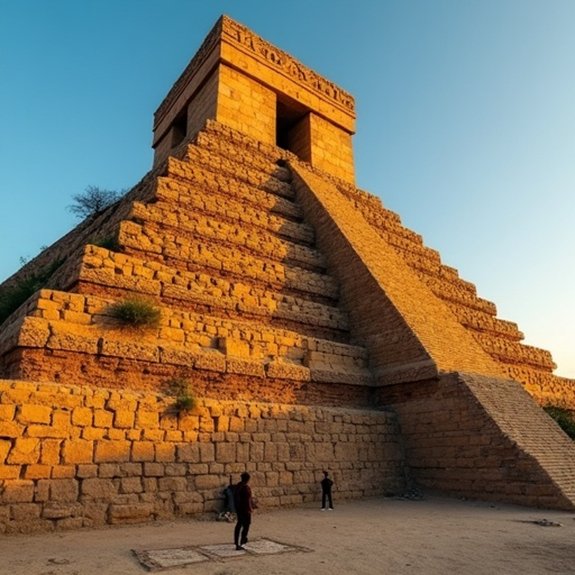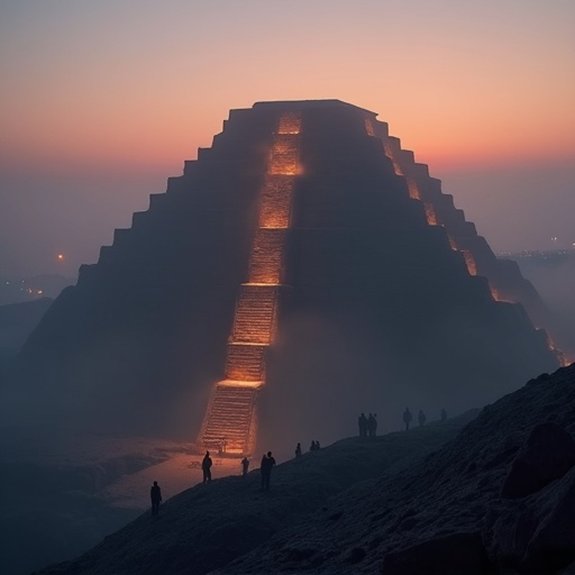The Mystery of the Etemenanki Ziggurat
The Etemenanki Ziggurat‘s true purpose remains one of archaeology’s most debated puzzles. While ancient texts describe Babylon’s massive seven-tiered temple reaching toward heaven, scholars can’t agree whether it inspired the Tower of Babel story or served another forgotten function. Recent excavations have uncovered conflicting evidence about its construction timeline and sudden abandonment. What drove the Babylonians to build such an ambitious structure, and why did they ultimately abandon it?
Introduction

When ancient travelers approached Babylon, they’d first glimpse the towering Etemenanki ziggurat rising from the Mesopotamian plain like a mountain crafted by human hands. This massive stepped temple, dedicated to Marduk, Babylon’s chief deity, dominated the city’s skyline for centuries. Its name meant “House of the Foundation of Heaven and Earth” in Akkadian, reflecting the Babylonians’ belief that it connected the mortal and divine domains.
Archaeological evidence suggests the structure stood approximately 91 meters tall, making it one of antiquity’s most ambitious architectural achievements. The ziggurat’s seven tiers, each painted a different color, symbolized the heavens’ layers. Many scholars believe Etemenanki inspired the biblical Tower of Babel story, cementing its place in both historical records and religious texts as humanity’s bold attempt to reach the gods.
Babylon’s Tower Reaching Heaven
The Etemenanki ziggurat‘s extraordinary height wasn’t just architectural ambition—it represented Babylon’s theological vision of bridging earth and heaven. Rising approximately 91 meters above Babylon’s plain, this seven-tiered structure dominated the ancient skyline. Each ascending level brought worshippers closer to Marduk, the city’s patron deity who resided in the temple crowning the summit.
The tower’s name, meaning “House of the Foundation of Heaven and Earth,” revealed its cosmic significance. Babylonians believed it marked the exact point where divine and mortal domains intersected. Priests climbed its massive stairways to perform rituals that maintained universal order. The structure’s blue-glazed bricks mimicked the heavens, while its base anchored firmly to earth. This vertical axis wasn’t merely symbolic—it functioned as Babylon’s spiritual center where gods descended to receive offerings and communicate with humanity.
Notable Cases or Sightings

Ancient historians recorded several firsthand accounts of Etemenanki’s imposing presence throughout Babylon’s history. Herodotus visited the site around 460 BCE and described eight stacked towers with a spiral path ascending the exterior. He noted the shrine at its summit contained a golden couch and table where priests claimed their god Marduk would rest.
Alexander the Great encountered the ziggurat’s ruins in 331 BCE. He’d planned to rebuild the structure but died before starting the project. His men spent two months clearing 600,000 tons of rubble from the site.
Strabo and other Greek writers documented the tower’s deteriorating condition during the Seleucid period. By the first century CE, Roman historian Pliny reported only foundations remained visible, marking Etemenanki’s final disappearance from historical record.
Common Theories or Explanations
While archaeological evidence confirms Etemenanki’s existence as a massive ziggurat in ancient Babylon, scholars have long debated its connection to the biblical Tower of Babel story. Many historians believe the structure’s impressive height and Babylon’s linguistic diversity inspired the Genesis narrative. The ziggurat’s name, meaning “House of the Foundation of Heaven and Earth,” supports this theory.
Alternative explanations suggest the tower represents humanity’s technological ambition rather than divine punishment. Some researchers propose it’s a metaphor for political fragmentation following Babylon’s decline. Linguistic studies indicate the story might explain why ancient Mesopotamian cultures spoke different languages despite geographical proximity. Archaeological findings show Etemenanki underwent multiple reconstructions, suggesting each ruler’s attempt to complete it failed, potentially fueling the biblical account of divine intervention.
Frequently Asked Questions
How Long Did It Take to Construct the Etemenanki Ziggurat?
Historians don’t know exactly how long Etemenanki’s construction took. Ancient records suggest Nebuchadnezzar II rebuilt it around 600 BCE, but earlier versions existed. The massive ziggurat likely required decades of continuous work to complete.
What Materials Were Used in Building the Ziggurat’s Foundation and Walls?
Builders used sun-dried mud bricks for the Etemenanki’s core structure and fired bricks for its outer walls. They’ve found evidence of bitumen mortar binding the materials together, while reed matting reinforced the foundation layers.
How Many Workers Were Involved in the Ziggurat’s Construction?
Historical records don’t provide exact numbers, but scholars estimate thousands of workers participated in Etemenanki’s construction. Babylonian texts suggest massive labor forces built these monuments, though specific workforce sizes for this ziggurat remain unknown.
What Rituals or Ceremonies Took Place at the Etemenanki Ziggurat?
Priests performed daily offerings to Marduk at Etemenanki’s summit temple, including food sacrifices and incense burning. They’ve documented annual New Year festivals where Babylon’s king climbed the ziggurat to symbolically renew divine authority through sacred marriage rituals.
Which Ancient Rulers Ordered Repairs or Renovations to the Structure?
Nabopolassar initiated major reconstruction of Etemenanki, while his son Nebuchadnezzar II completed the massive project. Earlier rulers like Esarhaddon and Ashurbanipal conducted repairs, but Alexander the Great’s planned restoration wasn’t finished before his death.


